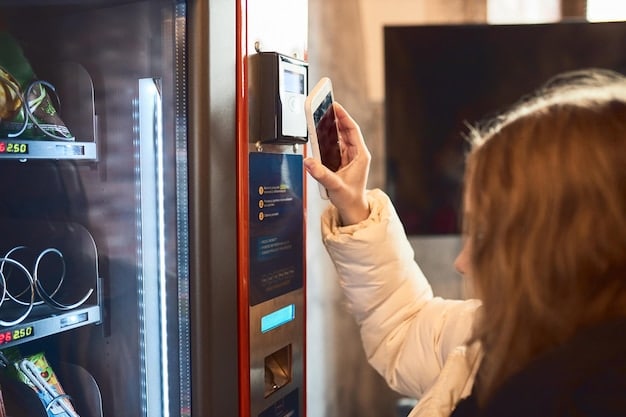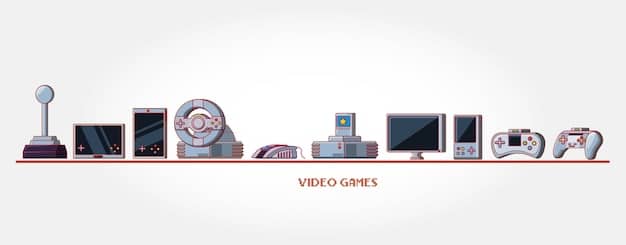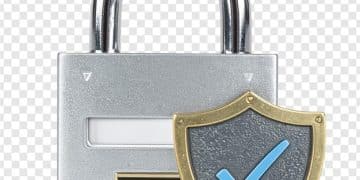Smart Contract Standards: ERC-721 and ERC-1155 in 2025

Smart contract standards like ERC-721 and ERC-1155 define how non-fungible tokens (NFTs) and multi-token assets are created and managed on blockchains, ensuring interoperability and streamlining development in decentralized applications.
The evolution of smart contract technology is significantly shaped by standardization, with ERC-721 and ERC-1155 leading the charge. Understanding Smart Contract Standards: Understanding ERC-721 and ERC-1155 in 2025 means anticipating how these protocols might evolve to meet the demands of a diverse and rapidly expanding blockchain ecosystem.
Understanding Smart Contracts: The Foundation
Smart contracts form the backbone of decentralized applications and blockchain technology. They are self-executing agreements written in code, facilitating the exchange of assets, services, or information when predetermined conditions are met.
What Defines a Smart Contract?
A smart contract is essentially a digital agreement stored on a blockchain. Its primary characteristic is its autonomy; once deployed, it executes automatically based on the rules programmed into it.
The immutability of a smart contract is another core feature. Once deployed, the code cannot be altered, thus ensuring that the terms of the agreement are upheld without intervention from a central authority.
- Immutability: Guarantees the contract’s code cannot be changed.
- Autonomy: Enables automatic execution based on predefined conditions.
- Transparency: Allows anyone to inspect the contract’s code.
Smart contracts offer a more secure, transparent, and efficient way to handle agreements compared to traditional methods. Their use cases range from financial applications to supply chain management.

ERC-721: The Pioneer of NFTs
ERC-721 introduced the concept of unique digital assets known as non-fungible tokens (NFTs). Each token is distinct, representing ownership of a specific item, whether it’s digital art, a virtual collectible, or real-world property.
Key Features of ERC-721 Tokens
ERC-721 tokens are designed to be indivisible and unique. They provide a standard interface for tracking ownership and facilitating transfers.
The standard defines functionalities such as tracking the owner of a token, transferring tokens from one account to another, and authorizing third-party operators to manage tokens on behalf of the owner.
The ERC-721 standard has significant implications for digital ownership and the management of unique digital assets.
- Uniqueness: Each token represents a distinct asset.
- Ownership Tracking: A clear standard for tracking token ownership.
- Transferability: Enables easy transfer of ownership between accounts.
ERC-721’s impact on the digital art market and collectible space has been monumental. It has also found applications in areas like real estate tokenization and identity management.
ERC-1155: The Multi-Token Standard
ERC-1155 takes a different approach by allowing the creation of both fungible and non-fungible tokens within a single smart contract. This multi-token standard streamlines the management of various asset types.
Advantages of ERC-1155 Over ERC-721
ERC-1155 offers several advantages over ERC-721, particularly when it comes to managing multiple types of tokens or many tokens of the same type.
One of the main benefits is reduced gas costs for batch transfers. ERC-1155 also supports both fungible and non-fungible tokens, providing greater flexibility.
The ERC-1155 standard is particularly suited for use cases like gaming, where multiple item types need to be managed, and for supply chain applications, where batches of products can be tracked as fungible tokens.

Potential Evolution of ERC-721 in 2025
Looking ahead to 2025, we can anticipate several potential developments for the ERC-721 standard. These could include enhancements to metadata, improved security measures, and innovations in fractional ownership.
Metadata Enhancements and Rich Media Support
Enhanced metadata standards could allow for richer descriptions and more detailed attributes for ERC-721 tokens. This would make tokens more descriptive and valuable.
Integration with rich media formats like videos and interactive 3D models could become more common, enhancing the user experience and making NFTs more engaging.
The introduction of dynamic metadata that updates based on real-world events or conditions is another possibility. This would add a new layer of interactivity and relevance to NFTs.
- Richer Descriptions: Providing detailed token attributes.
- Rich Media Integration: Incorporating videos and 3D models.
- Dynamic Metadata: Updating token attributes based on external events.
These enhancements could broaden the appeal of ERC-721 tokens and make them more useful in a variety of applications.
Future Enhancements for ERC-1155
For ERC-1155, potential future enhancements could focus on improved interoperability, expanded use cases in enterprise applications, and advancements in token composability. These improvements would leverage the standard’s adaptability and flexibility.
Interoperability and Cross-Chain Compatibility
Improved interoperability standards could allow ERC-1155 tokens to be easily traded and used across different blockchain networks. This would greatly increase their liquidity and utility.
Support for cross-chain transfers and interactions is crucial for expanding the reach of ERC-1155 tokens and making them compatible with a wider range of applications.
Standardized interfaces for interfacing with off-chain data and services could also be developed, opening up new possibilities for token-based interactions.
The increased interoperability would enhance the utility and value of ERC-1155 tokens significantly.
The Broader Impact on Smart Contracts in 2025
By 2025, the continued development of ERC-721 and ERC-1155 standards will have a profound impact on the broader smart contract ecosystem. This includes innovation in other verticals.
Enterprise Adoption of Smart Contract Standards
Enterprises are increasingly exploring the use of smart contracts to streamline business processes, enhance transparency, and reduce costs.
The adoption of ERC-721 and ERC-1155 standards could accelerate this trend by providing a standardized way to manage digital assets and intellectual property.
Supply chain management, voting systems, and digital identity solutions could all benefit from the use of these standards.
- Streamlined Business Processes: Improving efficiency and reducing costs.
- Enhanced Transparency: Providing greater visibility and accountability.
- Digital Asset Management: Simplifying the tracking and management of digital assets.
As enterprises become more familiar with the capabilities of smart contracts, we can expect to see more innovative and impactful use cases emerge.
| Key Concept | Brief Description |
|---|---|
| 🔑 ERC-721 | Standard for unique NFTs, ensuring distinct digital asset ownership. |
| 🔂 ERC-1155 | Multi-token standard managing both fungible and non-fungible tokens efficiently. |
| 🚀 Future Trends | Metadata enhancements, interoperability, and enterprise adoption drive future standards. |
| 🤝 Interoperability | Key focus for ERC-1155, enabling cross-chain transfers and broader utility. |
Frequently Asked Questions
▼
ERC-721 is designed for unique, non-fungible tokens, while ERC-1155 can handle both fungible and non-fungible tokens in a single contract, offering greater flexibility and efficiency in various applications.
▼
ERC-1155 reduces gas costs by allowing batch transfers of multiple tokens in a single transaction, which is more efficient than transferring each ERC-721 token individually.
▼
Future ERC-721 use cases include richer metadata for enhanced token descriptions, integration with rich media like videos and 3D models, and fractional ownership of high-value assets.
▼
ERC-1155 can improve interoperability through standardized interfaces for cross-chain transfers and interactions, allowing tokens to be easily traded and used across different blockchain networks.
▼
By 2025, ERC-721 and ERC-1155 standards could streamline business processes, enhance transparency, and simplify digital asset management, accelerating the adoption of smart contracts in enterprise environments.
Conclusion
As we look to the future, the continued evolution of smart contract standards like ERC-721 and ERC-1155 is set to transform the blockchain landscape. These standards drive innovation, improve interoperability, and unlock new possibilities for decentralized applications.





